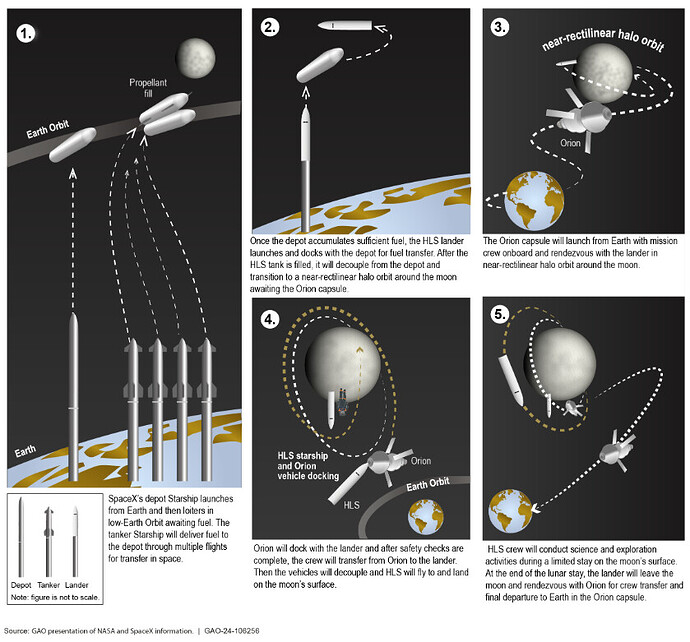On 2023-11-30, the U.S. Government Accountability Office (I find it difficult not to giggle when pronouncing that name) issued a new report on NASA’s Artemis project, “NASA Artemis Programs: Crewed Moon Landing Faces Multiple Challenges”. Here are the “Fast Facts” from the report.
NASA is taking steps to return astronauts to the moon for the first time since 1972—in a mission called Artemis III.
NASA and its contractors made progress since our last report on the Artemis missions, but they are still facing challenges with developing the lunar lander and space suits. For example, some flight tests have been delayed, which could affect the timing of subsequent tests. And a significant amount of complex work remains. As a result, we found that the lunar landing mission is unlikely to occur in 2025 as planned.
In the course of our work, NASA stated it was reviewing the schedule for developing the lunar lander.
The “Fast Facts” are about the only thing “fast” mentioned in the report. From “Highlights—What GAO Found”:
An ambitious schedule: The Human Landing System program is aiming to complete its development—from project start to launch—in 79 months, which is 13 months shorter than the average for NASA major projects. The complexity of human spaceflight suggests that it is unrealistic to expect the program to complete development more than a year faster than the average for NASA major projects, the majority of which are not human spaceflight projects. GAO found that if development took as long as the average for NASA major projects, the Artemis III mission would likely occur in early 2027.
Delays to key events: As of September 2023, the Human Landing System program had delayed eight of 13 key events by at least 6 months. Two of these events have been delayed to 2025—the year the lander is planned to launch. The delays were caused in part by the Orbital Flight Test, which was intended to demonstrate certain features of the launch vehicle and lander configuration in flight. The test was delayed by 7 months to April 2023. It was then terminated early when the vehicle deviated from its expected trajectory and began to tumble. Subsequent tests rely on successful completion of a second Orbital Flight Test.
A large volume of remaining work: SpaceX must complete a significant amount of complex technical work to support the Artemis III lunar landing mission, including developing the ability to store and transfer propellant while in orbit. A critical aspect of SpaceX’s plan for landing astronauts on the moon for Artemis III is launching multiple tankers that will transfer propellant to a depot in space before transferring that propellant to the human landing system. NASA documentation states that SpaceX has made limited progress maturing the technologies needed to support this aspect of its plan.
Design challenges: Axiom is leveraging many aspects of NASA’s prior work to develop modernized space suits, but significant work remains to resolve design challenges. For example, NASA’s original design did not provide the minimum amount of emergency life support needed for the Artemis III mission. As a result, Axiom representatives said they may redesign certain aspects of the space suit, which could delay its delivery for the mission.
Read the full report [PDF, 47 pages].
When the George W. Bush administration launched the Constellation program in 2004, its stated goal was “return to the Moon no later than 2020”. After a Marx brothers series of cancellations, re-scopings, redesigns, commercial competitions, and renamings, if Artemis III manages to land on the Moon in 2027, that will be 23 years after the U.S. proclaimed its “return to the Moon” and seven years after the original goal for that milestone. Artemis, which on the NASA side uses the Space Launch System (SLS), which is cobbled together from 1970s era parts of the Space Shuttle (for its early launches, literally from leftover hardware, some removed from museums), stands in contrast to the Apollo program, which went from Kennedy’s “landing a man on the Moon” speech in May 1961 to Tranquillity Base in July 1969, a little more than eight years, during which entirely new spacecraft, launchers and their engines, and launch facilities had to be developed from scratch.
